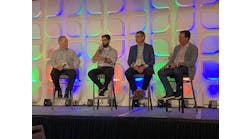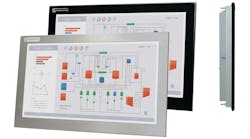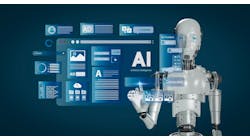Open systems and low-code options accelerate data acquisition
Dave Boeldt is product manager at Bosch Rexroth.
What have been the biggest improvements to machine-controls technology in the past five years?
Dave Boeldt, product manager at Bosch Rexroth: The biggest improvements in machine-controls technology is automation’s move toward open standards—OPC and MQTT—and their continuing expansion, as industries move toward the Industrial Internet of Things (IIoT), artificial-intelligence (AI) solutions and digitalization. These open standards will provide new and existing machines a method to connect, monitor and analyze data to improve their overall equipment effectiveness (OEE) and increase production. In the past, it was sufficient for machines to be connected to a SCADA system, connected to a manufacturing execution system (MES) or enterprise resource planning (ERP) system. Users want production information immediately via a dashboard on their phones. Besides monitoring production, users will be able to collect data and apply AI analytics to get better insight into problem areas and improve operational patterns.
Also read: 8 tips for PLC design
What’s the most innovative or efficient machine-controls technology application you’ve ever seen or been involved with?
Dave Boeldt, product manager at Bosch Rexroth: We worked with DW Fritz, a global provider of engineered-to-order precision automation, metrology and inspection solutions for advanced manufacturing. The application is a new, flexible, high-throughput and fully automated battery production line. The production line was designed to fit into a very small footprint and had a very short delivery timeframe. The motion system required high precision, and one control was used to position more than 50 axes of motion. The controller was integrated to query the machine and get real-time data. The digital-twin functionality offered a software platform to provide the engineers an immediate headstart with working on the project months before the machine was built.
How has machine-controls technology benefitted from remote monitoring and connectivity?
Dave Boeldt, product manager at Bosch Rexroth: Remote monitoring has provided OEMs and end users the capability to monitor, update and troubleshoot the machine’s operations quickly, without on-site personnel. The main benefit is to prevent machine downtime. Also, it can save the company time and expenses to provide an on-site service person. With remote monitoring, it is possible to establish a baseline for the machine’s functional operations, along with operational thresholds. If a threshold is exceeded, the maintenance department can be notified, prior to a component failure. Also, the OEM can be notified to potentially provide a replacement part.
Can you explain how software development has changed machine controls in discrete manufacturing?
Dave Boeldt, product manager at Bosch Rexroth: When designing a machine, the software integration has the same level of importance as the mechanical and electrical integration. Software development has been a major component for connecting the information technology (IT) with the operational technology (OT). The fast and secure methods that integrate these technologies provide the production information that identifies bottlenecks and improves the overall manufacturing process.
How do control technologies figure into digital-twin platform models being used by manufacturers?
Dave Boeldt, product manager at Bosch Rexroth: Since the digital twin will provide a simulation model, representing a manufacturing system, the control’s technology is an important component, not only for the development and commissioning, but also for determining the efficiency. The digital twin will develop a software model based on the physical components and the control capabilities, along with the processes—inputs, outputs, data. This information will help the digital twin to model the overall state, respond to changes, predict outcomes and improve operational decisions.
When will machine controls become IT-friendly enough that engineers are no longer required for installation and operation?
Dave Boeldt, product manager at Bosch Rexroth: In the future, the data connection between the IT and OT worlds will be easier to configure, through standard interfaces and the use of low-code options to quickly connect, collect and display the required information. This will also depend on how the security is designed into the machine controls system.
What future innovations will impact the use of machine-controls technology in discrete-manufacturing operations?
Dave Boeldt, product manager at Bosch Rexroth: We see that the future control systems will be based on open, easy-to-use, flexible solutions.
Control systems that operate on proprietary software will be a thing of the past. The future control systems will be open, to give users a choice for integrating their application requirements. While traditional IEC61131-3 PLC programming languages will be an option, the future engineers will be more familiar with programming controls in the languages that suits their application requirements. For high-performance applications, the user can program in C/C++ or Google’s Go language. With machine-learning (ML) applications, Python can be the required language. Also, for ease-of-use, low code options, such as Node-Red and Blockly provide this functionality.
Tell us about your company’s state-of-the-art machine-controls technology for discrete manufacturing.
Dave Boeldt, product manager at Bosch Rexroth: When designing our new ctrlX Automation platform, along with using state-of-the-art components, our main priorities were to create secure, open and easy-to-use automation solutions that are focused on the needs of our users, now and in the future. Within our ctrlX Automation platform, the modular ctrlX Core control system meets and expands the growing requirements for combining PLC, motion and Internet-of-Things (IoT) applications. The ctrlX Core control system is built on a 64-bit multi-core central processing unit (CPU) and utilizes the EtherCAT automation bus to control servo drives, I/O and other peripheral devices. In order to meet the user’s needs, the ctrlX Core operating system is based on the open source, Linux Ubuntu Core, embedded operating system, with real-time and functional extensions that allow users to tailor their requirements, via apps, from the ctrlX Store. This new automation platform enables an open ecosystem that allows users to quickly select and integrate the functionality for the application, but it also allows users to create their own apps, by using our software development kit (SDK). With this new approach, we have established third-party partnerships with companies, called ctrlX World. Our ctrlX World partners can develop apps to integrate their products into the ctrlX Core, which further expands the ecosystem. With the ctrlX Automation platform, it will continue to connect the worlds of IT and OT, as digitalization progresses, into the future.







